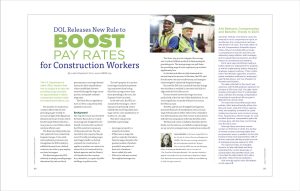DOL Releases New Rule to Boost Pay Rates for Construction Workers
The U.S. Department of Labor (DOL) issued a final rule on August 8 to raise the
prevailing wage standard for approximately 1 million construction workers under the federal Davis-Bacon Act.
The number of construction workers affected by the new prevailing wages is likely to increase in light of the Bipartisan Infrastructure Law of 2021, which funded many federal infrastructure projects, senior Biden administration officials said.
The final rule will provide periodic updates for non-collectively bargained wages. It also adds anti-retaliation provisions and strengthens the DOL’s ability to withhold money from a federal contractor in order to pay employees their lost wages.
The final rule gives the DOL authority to adopt prevailing wages determined by state and local governments, issue wage determinations for labor classifications where insufficient data was received through the wage survey process, and update outdated wage rates.
The Davis-Bacon regulations have not been comprehensively updated in 40 years.
Background
The Supreme Court has described the Davis-Bacon Act as “a minimum wage law designed for the benefit of construction workers,” the DOL noted in its summary of the proposed rule. The law, enacted in 1931, requires the payment of locally prevailing wages and fringe benefits on federal contracts for construction. It applies to workers on contracts in excess of $2,000 entered into by federal agencies and the District of Columbia for the construction, alteration, or repair of public buildings or public works.
The law’s purpose is to protect local wage standards by preventing contractors from basing their bids on wages lower than those prevailing in the area, the Supreme Court has noted.
In the new rule, the DOL recommended returning to a three-step process previously used to identify the most frequently used wage rate for each classification of workers in a locality.
This three-step process identified as prevailing:
- Any wage rate paid to a majority of workers.
- If there was no wage rate paid to a majority of workers, then the wage rate paid to the greatest number of workers, provided it was paid to at least 30% of workers— the so-called 30% rule.
- If the 30% rule was not met, the weighted average rate.
The three-step process relegated the average rate to a final, fallback method of determining the prevailing rate. The average wage can pull down the prevailing wage if some employers pay workers significantly less.
A rule that took effect in 1983 eliminated the second step in the process. At the time, the DOL said that the 30% rule may be inflationary, and may give undue weight to collectively bargained wages.
But now the DOL has concluded that this change was mistaken or resulted in outcomes that did not align with the Davis-Bacon Act.
Recent research shows that wage increases, particularly at the low end of the distribution, do not cause significant, economy-wide price increases, the DOL has said.
The DOL said the use of weighted averages has increased from 15% of classification rates across all wage determinations before 1982 to 64% of classification determinations now. This overuse is inconsistent with the text and purpose of the law, the DOL noted.
The final rule comes as inflation has fallen by two-thirds over the last year, and inflation-adjusted wages are up 2.4% for nonsupervisory construction workers.

